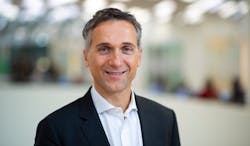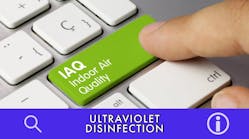Signify CEO reports strong demand for UV-C but refrains from quantifying sales
Signify’s CEO has reported “strong demand” in the company’s all-out ramp up of UV-C products aimed at killing the coronavirus, although it is too early to forecast sales, which in the second quarter did not prevent a 22.5% decline in overall corporate revenue amid the pandemic. Cost cutting enabled a profit.
Boss Eric Rondolat signaled the UV-C push this past April, when the company began adding capacity and developing disinfection systems using UV-C, a form of ultraviolet radiation emitted by the company’s conventional mercury-vapor technology.
Sales of conventional (non-LED) products tumbled 25.2% on a comparable basis in the second quarter ending June 30, but UV-C and conventional horticultural lighting products mitigated the fall.
“The division showed a solid performance partly as a result of strong demand for UV-C and horticultural lighting,” Rondolat said on a conference call with analysts discussing second quarter results last Friday. “We believe that the decline in sales is lower than the overall market decline, resulting in continued market share gains.”
On a non-comparable basis, sales for the conventional group slipped by 26.5% to €211 million ($247.38M). Signify acquired Cooper Lighting Solutions in the US and China’s Zhejiang Klite Lighting Holdings Co., Ltd. since the second quarter of 2019, so sales of those two entities are not included in “comparable.” Income for the conventional business was down 11% at €45M ($52.76M).
Rondolat told analysts that Signify’s UV-C efforts “will continue at a very high pace until the end of the year.” The company is applying 35-year old mercury tubes and is developing luminaires, chambers, robots, and other products to help deliver virus-killing UV-C in different environments. For example, ceiling-mounted fixtures can point UV-C upwards at circulating air in schools and offices; clothing retailers and supermarkets can put garments and carts in UV-C tunnels and chambers; and robots on wheels can shine UV-C down either side of aisles while stores are closed.
UV-C is hazardous to skin and eyes and thus cannot be used directly when people are present. Boston University has determined that a Signify UV-C light source would almost always deactivate the coronavirus that causes COVID-19 if dosed at the right level.
Rondolat outlined a broad market for UV-C products including schools, retails, offices, manufacturing plants, warehouses, and many others. But he refrained from quantifying the revenue potential.
“We’re developing the applications at this point in time,” he said when one analyst pressed him for details. “We are sizing the market as we speak because it’s evolving on a daily basis. It’s a moving target at this point in time.”
Most people would agree that “moving target” probably also describes the general economy as the pandemic continues. Signify weathered the last quarter by using €43M ($50.42M) in cost cutting to help stimulate a 61.5% spike in corporate net income to €81M ($94.97M), even as sales tumbled 22.5% on a comparable basis. On a non-comparable basis, including Cooper and Klite, sales slipped only 0.6%, to €1.47 billion ($1.72B).
The savings came mostly from a three-month initiative in which staff volunteered to take a 20% reduction in work and pay. Some of it came from government support in countries including the US, Canada, France, Germany, and Singapore.
The employee slowdown scheme has ended, so Signify will not be able to duplicate its one-time effect in the third quarter.
“We’re not pursuing that initiative in Q3,” Rondolat said. “It was only something that we really wanted to do in Q2.”
Rondolat also noted that the market for LED goods and services has been characterized by less price pressure than in normal times, which helped support profit margins. He anticipated that the situation “will continue for a while,” although he expects competitive pricing pressures to eventually return.
Like many companies amid the health crisis, Signify withdrew specific financial guidance earlier this year, and is not yet issuing a new forecast.
Rondolat told one analyst that he expects a “sequential improvement in both Q3 and Q4,” but cautioned that “the situation is extremely volatile and a level of uncertainty remains.”
The world’s largest lighting company also reported that free cash flow increased to €158M ($185.26M), up from €121M ($141.87M) a year earlier. That stands out in contrast to industry number-two Osram, which has been eating through cash. Osram, which has been acquired by Austrian sensor maker ams, is scheduled to report quarterly results tomorrow.
In other second-quarter developments, Signify reported that its integration of Cooper is ahead of schedule, and that Signify expects to achieve carbon neutrality by the end of this year.
MARK HALPER is a contributing editor for LEDs Magazine, and an energy, technology, and business journalist ([email protected]).
For up-to-the-minute LED and SSL updates, why not follow us on Twitter? You’ll find curated content and commentary, as well as information on industry events, webcasts, and surveys on our LinkedIn Company Page and our Facebook page.

Mark Halper | Contributing Editor, LEDs Magazine, and Business/Energy/Technology Journalist
Mark Halper is a freelance business, technology, and science journalist who covers everything from media moguls to subatomic particles. Halper has written from locations around the world for TIME Magazine, Fortune, Forbes, the New York Times, the Financial Times, the Guardian, CBS, Wired, and many others. A US citizen living in Britain, he cut his journalism teeth cutting and pasting copy for an English-language daily newspaper in Mexico City. Halper has a BA in history from Cornell University.





